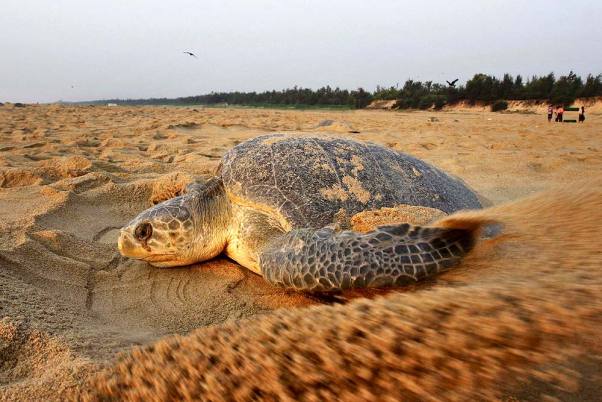Kendrapara: Over two crores of endangered Olive ridley sea turtle hatchlings emerged from the egg shells at the mass nesting sites of Nasi-2, the world’s largest rookery of the species in Gahirmatha marine sanctuary.
Rajnagar Mangrove( forest )and Wildlife Division DFO Sudarshan Gopinath Jadhav on Tuesday said within a span of four days from April 29 to May 2 the hatchlings emerged, marking the culmination of the annual rendezvous of the marine species.
He said the emergence of hatchlings from egg shells is expected to continue for at least two more days . The babies broke out of the eggshells and wandered around the sandy beach for nearly an hour before making their way to swirling seawater.
This year as many as 5,12,175 Olive ridley sea turtles came ashore enmass to the golden beach of Nasi-2 within Gahirmatha Marine Sanctuary to lay eggs within a span of four days from March 9 to March 13 last .
Due to multi-layering at Nasi-2 ,more than 20 percent of laid eggs were destroyed in some of the segments during the mass nesting as turtles were laying eggs on the same spot ,by digging the
earth with its flipper and destroying the already laid eggs.
Later, the predators like crows and seagulls also destroyed some percentages of eggs laid in the
nest of sandy beaches .
The female olive Ridley sea turtles generally lay 100- 120 eggs in a go. They lay their eggs at midnight in 45 centimeters pits, which they dig 2-3 foot long pits to lay eggs with their rear flippers.
After laying the eggs in the pits, the female turtles cover the nests with sand and return to the sea
in a zigzag manner to confuse predators about the location of the nests.
Hatchlings emerge from the laid eggs after 45-55 days and find their way to the sea creating a cacophony, the DFO said.
Forest personnel have been deployed on the beach to protect and guard the hatchlings from predators and to pave the way for the marine turtles to crawl to the sea, Jadhav said.
Forest officials said in a nest most of the hatchlings coming from upper eggs of a nest are generally male whereas the lower part of the eggs emerge as female.
Once hatched, the turtles dig their way to the surface and scurry to the ocean. It is believed by some that imprinting on the earth’s magnetic field may occur upon their emergence from the sand.
This imprinting is believed to guide the hatchlings back to the same breeding areas at adulthood. If the hatchlings reach the ocean successfully, they will spend the next several years dispersing in ocean currents
It is one of Nature’s rare phenomena where babies grow without their mother. The endangered species mortality rate is so high that one egg out of every 1000 eggs laid, ultimately hatches and
the hatchlings survives to become an adult Olive Ridley, the DFO said
Although the species are very slow moving on land, they swim very quickly in water and take advantage of ocean currents to assist their migration.
Unlike their land based cousins, marine turtles have streamlined shells and paddles –like flippers
that can propel them at speeds of up to 50 km per hour.
As bright lights generally disorient the turtle hatchlings going to the sea, the authority of Defence Research and Development Organisation (DRDO) at Wheeler’s Island has masked the bright light coming from the Defence organization to the sea to provide a congenial atmosphere for the baby turtles to crawl into the sea water, Jadhav said.


